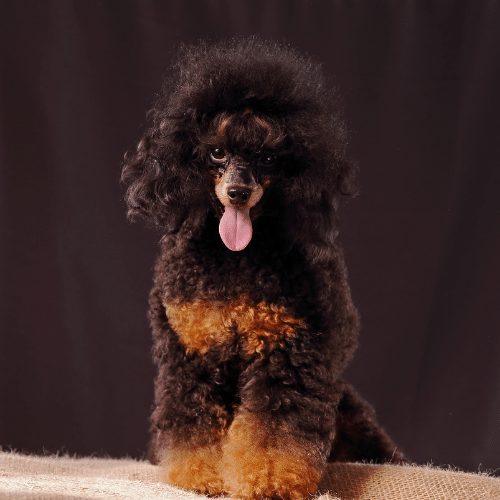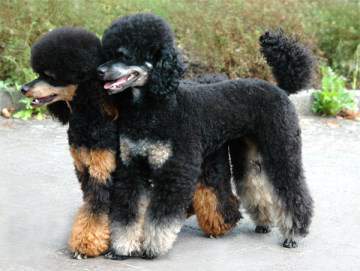A phantom poodle is a unique and fascinating breed that captivates dog lovers with its stunning coat coloration. Unlike traditional poodles, phantom poodles have a distinct color pattern featuring two or more different shades, creating a striking contrast that sets them apart from other dogs. This eye-catching characteristic makes phantom poodles a popular choice among dog enthusiasts.
Phantom poodles have a rich history and have been cherished by dog lovers for centuries. The breed originated in France and was originally bred for its impressive hunting skills. Over time, their intelligence and versatility made them ideal companions for various activities, such as field trials, obedience trials, and agility competitions. What sets phantom poodles apart is their unique coloration, which adds an extra layer of appeal to an already remarkable breed. With their striking appearance and exceptional abilities, phantom poodles continue to captivate the hearts of dog lovers worldwide.
A phantom poodle is a term used to describe a poodle with a specific coat color pattern. It refers to a poodle that has a solid base color (usually black or brown) with distinct markings of a lighter color on specific areas of the body, such as the head, legs, and chest. These markings can give the poodle a striking appearance. Phantom poodles are recognized by some breed clubs and are often seen as unique and beautiful dogs.

Unveiling the Mystery: The Phantom Poodle
When it comes to poodles, there are various coat patterns that make these dogs even more unique and intriguing. One such pattern is the phantom poodle. Although the name may evoke a sense of mystery, phantom poodles are simply poodles with a specific coat coloring pattern. In this article, we will explore what a phantom poodle is, delve into their distinct characteristics, and unveil the allure behind these beautiful dogs.
Understanding the Coat Coloration
A phantom poodle refers to a poodle with a specific two-tone coat coloration pattern. The coat of a phantom poodle consists of two distinct colors: a solid base color and specific markings in a different color. These markings usually appear on the head, legs, and sometimes the body of the dog. The base color is generally a solid color, while the markings are typically a lighter shade or a combination of lighter and darker shades.
The most common base colors for phantom poodles are black, brown, and blue. The markings can vary and include colors such as apricot, cream, silver, red, or even white. The pattern and intensity of the markings can differ from one phantom poodle to another, making each dog truly unique.
It’s important to note that phantom poodles are not a separate breed but rather a specific coat coloration pattern that can occur in any size variation of poodles, including standard, miniature, and toy.
Distinctive Characteristics of Phantom Poodles
Phantom poodles possess several distinctive characteristics that set them apart from other poodle coat colors. Here are some notable features:
- Their two-tone coat coloration pattern instantly catches the eye and makes them stand out in a crowd.
- Phantom poodles have a regal and elegant appearance, thanks to their unique coat markings.
- They have a playful and friendly temperament, making them great companions and family pets.
- Phantom poodles are highly intelligent and easily trainable, which enables them to excel in various dog sports and activities.
- They have a hypoallergenic coat, making them a suitable choice for individuals with allergies.
The Genetics Behind Phantom Poodles
Understanding the genetics of coat coloration in phantom poodles can shed light on how this unique pattern is inherited. Phantom poodles inherit the two-tone coat pattern through a process called “agouti expression.”
The agouti gene is responsible for the distribution of pigment in the coat. In phantom poodles, this gene causes some hair shafts to produce the solid base color, while others produce the alternate color for the markings. The exact expression of the agouti gene can vary, resulting in different degrees of contrast and intensity of the coat pattern among phantom poodles.
Care and Maintenance of Phantom Poodles
Like all poodles, phantom poodles require regular grooming to keep their coat in good condition. Here are some essential care tips for phantom poodles:
1. Regular brushing: Phantom poodles have a dense and curly coat, so regular brushing is necessary to prevent matting and tangling of the hair.
2. Professional grooming: Scheduling regular visits to a professional groomer will help maintain the desired shape and appearance of the phantom poodle’s coat.
3. Bathing: Phantom poodles should be bathed on a regular basis using a mild dog shampoo to keep their coat clean and free of dirt or debris.
4. Ear cleaning: Regular ear cleaning is essential to prevent ear infections, especially in poodles with floppy ears.
5. Dental care: Phantom poodles, like all dogs, should have their teeth brushed regularly to maintain good oral hygiene and prevent dental problems.
The Popularity of Phantom Poodles
Phantom poodles have gained significant popularity among dog enthusiasts and poodle lovers due to their unique and eye-catching coat pattern. Their regal appearance, combined with their friendly and intelligent nature, makes them a sought-after breed. Many phantom poodles excel in dog shows, agility competitions, and obedience trials, showcasing their versatility and trainability.
The Phantom Poodle: An Enigmatic Beauty
In conclusion, a phantom poodle is a poodle with a distinct two-tone coat coloration pattern. These dogs possess an intriguing and alluring appearance that leaves a lasting impression. Their playful and friendly temperament, coupled with their intelligence, makes them wonderful companions and beloved family pets. Whether you’re drawn to their regal elegance or their unique coat markings, the phantom poodle will continue to captivate dog lovers around the world.
Key Takeaways:
- A phantom poodle is a specific coloring pattern found in poodles where they have a solid base color with distinct markings that resemble a phantom.
- Phantom poodles are recognized in various dog registries, including the American Kennel Club (AKC).
- The phantom coloring is a result of specific genes present in the poodle’s genetic makeup.
- Phantom poodles can come in different coat colors, such as black and tan, brown and tan, or silver and tan.
- Phantom poodles require regular grooming and maintenance to keep their coat healthy and free from mats.
Frequently Asked Questions
The following are some commonly asked questions about phantom poodles:
1. What is the coat color of a phantom poodle?
Phantom poodles have a unique coat color pattern consisting of a solid base color with specific markings. The base color is generally a light shade, such as cream or silver, while the markings are generally a darker shade, such as black or brown. The markings appear on specific areas of the body, including the eyebrows, cheeks, front legs, and tail. This striking coat color pattern sets phantom poodles apart from other poodle varieties.
The phantom coat color pattern is inherited genetically and is recognized by major kennel clubs. It is a highly desirable trait for poodle enthusiasts due to its visual appeal and rarity.
2. Are phantom poodles a separate breed?
No, phantom poodles are not a separate breed. They belong to the standard, miniature, or toy poodle breed. The phantom coat color pattern is a variation within the poodle breed and is recognized by kennel clubs. While phantom poodles are not a distinct breed, they have specific characteristics that distinguish them, such as their unique coat color pattern.
Phantom poodles share the same overall physique, temperament, and health characteristics as other poodles. Their coat color pattern is the main feature that sets them apart.
3. How is the phantom coat color pattern inherited?
The phantom coat color pattern is inherited through genetics. It is a recessive trait that requires both parents to carry the phantom gene in order for it to be expressed in their offspring. Each parent must contribute a copy of the phantom gene for a puppy to have the phantom coat color pattern.
The inheritance of the phantom gene follows Mendelian genetics, where the gene can be passed down from previous generations even if the parents themselves do not exhibit the phantom coat color pattern. Breeders carefully select and pair poodles that carry the phantom gene to produce phantom poodle puppies.
4. What is the temperament of phantom poodles?
Phantom poodles share the same temperament as other poodle varieties. They are known for being intelligent, lively, and highly trainable. Poodles, including phantom poodles, are generally friendly, loyal, and good with families, making them excellent companions.
Their intelligence and eagerness to please make them quick learners, which allows them to excel in various activities, including obedience training, agility, and other dog sports.
5. Are phantom poodles recognized by kennel clubs?
Yes, phantom poodles with the appropriate coat color pattern are recognized and accepted by major kennel clubs, including the American Kennel Club (AKC) and the Kennel Club (UK). The phantom coat color pattern is considered a valid and desirable variation within the poodle breed standard.
Phantom poodles can participate in conformation shows and other performance events, where their coat color pattern is considered a unique feature.

Phantom Poodle – Breed Profile, Description – Petdii.com
A phantom poodle refers to a rare color variation of the standard poodle breed. It is characterized by a coat color that appears to be solid black, but upon closer inspection, it reveals faint markings of another color, usually silver or gray.
This unique coloring is caused by a combination of genetics and the presence of the fading gene, which causes the secondary color to fade away over time. Phantom poodles are highly sought after for their striking appearance and are often favored in dog shows and competitions.
